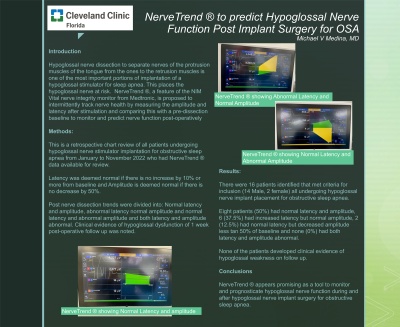Sleep Medicine
(329) Nerve Trend (R) to Predict Hypoglossal Function Post Implant Surgery
Monday, October 2, 2023
2:45 PM - 3:45 PM East Coast USA Time

Has Audio
- MM
Michael V. Medina, MD
Staff Physician
Cleveland Clinic Florida
Weston, Florida, United States
Presenting Author(s)
Disclosure(s):
Michael V. Medina, MD: No relevant relationships to disclose.
Introduction: Hypoglosaal nerve dissection to separate protrussor from retrussor branches is one of the most important part of hypoglossal implant surgery placing the nerve at risk. Nerve trend (R) is proposed to intermittently track nerve health by measuring the amplitude and latency comparing this with pre-dissection baseline to monitor and predict nerve function post-operatively
Methods: This is a retrospective chart review of all patient undergoing hypoglossal nerve implantation for obstructive sleep apnea from January to November 2022 who had Nerve Trend (R) data available for review. Latency was deemed normal if there is no increase by 10% and amplitude normal if it did not decrease by 50%. Post nerve dissection trends were divided into: Normal latency and amplitude, abnormal latency normal amplitude and normal latency and abnormal amplitude and both latency and amplitude abnormal. Clinical evidence of hypoglossal dysfunction of 1 week post-operative follow up was noted.
Results: There were 16 patients identified that met criteria for inclusion (14 Male, 2 female) all undergoing hypoglossal nerve implant placement for obstructive sleep apnea. Eight patients (50%) had normal latency and amplitude, 6 (37.5%) had increased latency but normal amplitude, 2 (12.5%) had normal latency but decreased amplitude less tan 50% of baseline and none (0%) had bot latency and amplitude abnormal.
None of the patients developed clinical evidence of hypoglossal weakness on follow up.
Conclusions: Nerve Trend (R) appears promising as a tool to monitor and prognosticate hypoglossal nerve function during and after hypoglossal nerve implant surgery for obstructive sleep apnea.
